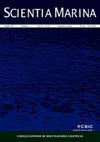Bahía白卡河口潮滩与互花米草定殖盐沼区中大型底栖动物群落结构及有机碳含量的变化
IF 0.9
4区 生物学
Q4 MARINE & FRESHWATER BIOLOGY
引用次数: 0
摘要
盐沼被认为是最具生产力的沿海生态系统之一,是重要的"蓝碳"汇,是丰富的底栖生物群落的支撑,其结构可能受到盐沼植被的强烈影响。在过去的几十年里,互花米草一直在Bahía布兰卡河口的光秃秃的泥滩上定居,据报道,盐沼覆盖的面积大幅增加。这种定植可以强烈地影响底栖动物的结构及其在碳循环中的作用。本研究的假设是互花草在潮滩和盐沼间的群落结构和大型底栖动物的有机碳含量发生了变化。对比滩涂和盐沼的响应变量为密度、生物量和大型和小型底栖生物产量/生物量(P/B)比。盐沼区腹足类密度、生物量和线虫P/B比均高于潮滩区。滩涂多毛藻的密度和生物量均高于滩涂。这些结果表明,潮滩互花草沼泽的扩张引起了大、小底栖生物群落结构(分类组成和生物量)的变化,并对碳循环产生影响。本文章由计算机程序翻译,如有差异,请以英文原文为准。
Change in the community structure and organic carbon content of meio- and macrobenthos between tidal flat and salt marsh areas colonized by Spartina alterniflora in the Bahía Blanca estuary (SW Atlantic)
Salt marshes are regarded as among the most productive coastal ecosystems, important “blue carbon” sinks and a support for benthic communities with large abundances, whose structure may be strongly influenced by salt marsh vegetation. During the last few decades, Spartina alterniflora has been colonizing bare mudflats in the Bahía Blanca estuary, and a large increase in the area covered by salt marshes has been reported. This colonization can strongly influence the structure of benthic fauna and its role in the carbon cycle. The hypothesis of this study was that the community structure and the organic carbon contained in the meio- and macrobenthos change between tidal flats and salt marshes recently colonized by S. alterniflora. Response variables studied to compare the tidal flat and salt marsh were density, biomass and production to biomass (P/B) ratio of macro- and meiobenthos. Density and biomass of Gastropoda and P/B ratio of Nematoda were higher on the salt marsh than on the tidal flat. By contrast, density and biomass of Polychaeta were higher on the tidal flat. These results suggest that the expansion of S. alterniflora marshes on tidal flats produces changes in the structure of the macro- and meiobenthos community (taxonomic composition and biomass) that have an influence on carbon cycling.
求助全文
通过发布文献求助,成功后即可免费获取论文全文。
去求助
来源期刊

Scientia Marina
生物-海洋与淡水生物学
CiteScore
2.10
自引率
0.00%
发文量
21
审稿时长
6-12 weeks
期刊介绍:
Scientia Marina is the successor to Investigación Pesquera, a journal of marine sciences published since 1955 by the Institut de Ciències del Mar de Barcelona (CSIC). Scientia Marina is included in the Science Citation Index since 1998 and publishes original papers, reviews and comments concerning research in the following fields: Marine Biology and Ecology, Fisheries and Fisheries Ecology, Systematics, Faunistics and Marine Biogeography, Physical Oceanography, Chemical Oceanography, and Marine Geology. Emphasis is placed on articles of an interdisciplinary nature and of general interest.
 求助内容:
求助内容: 应助结果提醒方式:
应助结果提醒方式:


